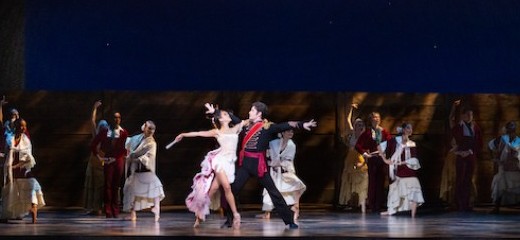
Searching For Duende in Philadelphia Ballet’s "Carmen"
by Courtney Henry
Angel Corella’s full-length rendition of Carmen, choreographed specifically for the dancers of Philadelphia Ballet, toed the line of freedom vs. control during the Sunday matinee performance at the Academy of Music.
The thumbprint of Corella’s native Spain was present in the costuming of exquisite lace and regal Matadorian coats, the rhythmic inserts of palmas (hand clapping), and the use of the Spanish cajon drum. In the second act, even the corps de ballet’s red-bottomed pointe shoes were used as a percussive instrument as they tapped their pointe shoe boxes onto wooden chairs.
The ballet stood strong in its Spanish authenticity through Corello’s choreographic choices, yet the translation onto the dancer's bodies at times felt unsound. Stomps of the feet read as pitter patter from where I sat; the claps and snaps of the supporting cast left the essence of duende to be desired.
In one scene at the Cigar Factory, the corps de ballet used a long wooden table for percussion. Hands and elbows struck the tables, and the ruffled skirts and intricate pointe work were seen from underneath.The nuanced percussion raised the stakes from previous versions of Carmen, yet execution fell short at the apron of the stage, never truly landing into my heart or onto my ears.
The ballet begins with Don José, danced that afternoon by Ashton Roxander, in a melodramatic solo bound within a cubed jail cell as he awaits his sentencing. Carmen’s silhouette looms in the far distance as she solemnly marches across the entire stage, her head bent as if in mourning, foreshadowing her tragic murder by the jealous José at the story’s end.
The wheeled wooden panels of Don José’s cell then smoothly—albeit unimaginatively—open up, transforming the space throughout the two, twenty-five minute Acts to become the Royal Cigar Factory, an intimate bedroom with shadowed light seductively peeking through the shades, and the bullfighters chapel, La Maestranza. I appreciate poking holes into the “magic” of theater by exposing scene transitions; however the use of these generic wooden panels felt mediocre amongst the decadent costuming.
Mayara Pineiro, originally from Cuba, brought seduction and brightness to her dancing of Carmen, driving the show. With brilliant rhythmic footwork and an open heart, she danced, led, and seduced from her chest, in true anti-heroine fashion. Her take on Carmen demonstrates the spirit of evocation, or duende, one of its four elements being “a heightened awareness of death.” It is her sexual choices and brash way of being in the world that are ultimately censored by the rage and jealousy of men who are drawn to her light but want to control it.
In a particularly human pas de deux in Act I, Carmen is first detained for essentially shanking a fellow factory worker, danced powerfully by Sydney Dolan. In this duet, Pineiro, hands tied behind her back, uses pure core and her legs to seduce Don José after her arrest, in a teasing act of struggle and vulnerability.
How refreshing it was to see the women of this show without tights; throughout the show they donned either bare legs or black-laced unitards. The main character’s embodiment of lust was accentuated by white and black, part leotard/part lace lingerie, during both bedroom pas de deux…a post-coital cigarette added to the theatrics.
In a previously recorded Philadelphia Ballet zoom interview, Music Director/Conductor Beatrice Jona Affron articulated that the music, originally composed by George Bizet, was rearranged in this version to “fill out” Bizet’s suites. While Carmen the opera traditionally runs for upwards of three hours, previous ballets have used very little of the original score. Their task of having to create transitions and weave together arrangements explains my yearning for deeper resonance, layers, textures, and sheer volume from the orchestra. It was a mirror of the dancing throughout the ballet, executed as light in its raw essence and underdeveloped overall.
Carmen’s affair with the matador, Escamillo, danced by soloist Pau Pujol, ignited questions within me about the difference between acting a character and becoming it. Perhaps it was the over the top “princely” demeanor to convey bravado. Perhaps it was the multiple forward facing turns, which to me felt like an insufficient choreographic means to move the narrative forward.
Corella’s version of Carmen places Don José’s torment of his actions as the bookends to this ballet. This choice highlights the angst of a murderer over the survival tactics of a woman who does not want to be controlled. It effectively tied the story together from beginning to end but in a way that decentered Carmen’s journey and point of view. The way Carmen moves through the story ballet ignites a chain reaction in all other characters, so I struggled with why she was not the focal point from the very beginning.
Duende, defined as “a quality of passion and inspiration,” is considered by many inextricably linked to the heart of Spanish Dancing. Whether Carmen’s story is translated into film, a theatrical play, or classical ballet, if the art does not lead from the soul, the authenticity, for me, is compromised.
Carmen, Philadelphia Ballet, Academy of Music, Oct. 5-15
By Courtney Henry
October 18, 2023





